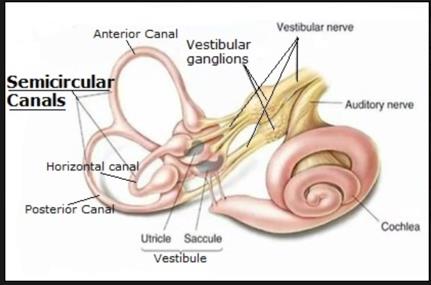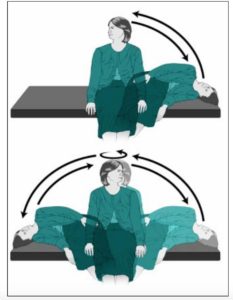Signs of Benign Paroxysmal Positional Vertigo (BPPV)
Have you experienced motion sickness and/or nausea with just simply turning your head or looking up? Have you laid down in bed for the night only to find yourself incredibly dizzy? Most likely it’s not your sinus headache or cold, but could be Benign Paroxysmal Positional Vertigo.
Hallmark signs of Benign Paroxysmal Positional Vertigo (BPPV):
- Brief (less than one minute) episodes of vertigo provoked by rolling over in bed, lying down, bending over, or looking up.
- Usually worse in the morning
- Can be absent for weeks or months before returning
 What is BPPV?
What is BPPV?
When free particles (otoliths) in the fluid of the cochlea find their way into the semicircular canals they are called canaliths. Normally, the semicircular canals are sensitive to rotation but when canaliths are abnormally present, all changes in head position are sensitive. This results in an overactive response to changes in gravity such as dizziness at rest or with movement, and subsequent nausea.
Treatment of BPPV
Your physician may prescribe anti-nausea medication to reduce the motion sickness associated with BPPV attacks.
Your physical therapist will perform positional tests to diagnose which ear is affected, which canal in the identified ear is affected, and whether the material is free-floating or attached to the vestibular structures.
Once diagnosis has been obtained, treatment will involve a canalith repositioning maneuver. Two very successful treatments are the Epley maneuver and the Liberatory maneuver. These involve assisted movements to dislodge the offending free particles and return them to their correct location in the inner ear. Often, a single treatment can be successful and additional visits may not be required.
If the Epley or Liberatory maneuver aren’t successful for you, don’t worry! Some people either cannot tolerate the positional changes required to complete those movements, or symptoms still remain after a few treatments. In those cases, performance of Brandt-Daroff exercises at home may be used for any affected canal of the ear. These exercises can be used to prevent or lessen further episodes and can help reduce the anxiety associated with movements that are known to cause motion-sickness.
Brandt-Daroff exercises begin by:
 Sitting upright at the edge of the bed with head turned 45 degrees to one side.
Sitting upright at the edge of the bed with head turned 45 degrees to one side.- You then move rapidly down into side-lying position, keeping the head turned in the same direction. Maintain this position until vertigo subsides, or at least 30 seconds.
- Then return to upright sitting for 30 seconds.
- The head is then turned to the opposite direction, and the same steps are followed on the other side.
- Repeat the whole sequence until vertigo is no longer experienced with changes in position.
These exercises may be performed several times a day and should continue until at least one full day after no symptoms of vertigo are experienced.


 What is BPPV?
What is BPPV?





